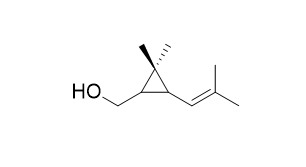trans-Chrysanthemyl alcohol
Reference standards.
Inquire / Order:
manager@chemfaces.com
Technical Inquiries:
service@chemfaces.com
Tel:
+86-27-84237783
Fax:
+86-27-84254680
Address:
1 Building, No. 83, CheCheng Rd., Wuhan Economic and Technological Development Zone, Wuhan, Hubei 430056, PRC
Providing storage is as stated on the product vial and the vial is kept tightly sealed, the product can be stored for up to
24 months(2-8C).
Wherever possible, you should prepare and use solutions on the same day. However, if you need to make up stock solutions in advance, we recommend that you store the solution as aliquots in tightly sealed vials at -20C. Generally, these will be useable for up to two weeks. Before use, and prior to opening the vial we recommend that you allow your product to equilibrate to room temperature for at least 1 hour.
Need more advice on solubility, usage and handling? Please email to: service@chemfaces.com
The packaging of the product may have turned upside down during transportation, resulting in the natural compounds adhering to the neck or cap of the vial. take the vial out of its packaging and gently shake to let the compounds fall to the bottom of the vial. for liquid products, centrifuge at 200-500 RPM to gather the liquid at the bottom of the vial. try to avoid loss or contamination during handling.
Heliyon.2023, e12684.
Phytochem Anal.2024, 35(3):483-492.
Front Pharmacol.2021, 12:762829.
J. Mater. Life Sci.2024, 3:2:78-87
Antioxidants (Basel).2023, 13(1):12.
Pharmacol Res.2022, 182:106346.
J Sep Sci.2022, 45(18):3556-3566.
J Hepatocell Carcinoma.2022, 9:327-341.
Preprints2024, 2085.v1
J Traditional Thai Medical Res.2022, 8(1):pp1-14.
Related and Featured Products
Phytochemistry, 1977, 16(1):85-92.
Biosynthesis of irregular monoterpenes in extracts from higher plants.[Reference:
WebLink]
METHODS AND RESULTS:
Extracts from Artemisia annua and Santolina chamaecyparissus converted 14C-labelled IPP, DMAPP and DMVC into artemisia ketone, its corresponding alcohol, lavandulol and trans-Chrysanthemyl alcohol with up to 12.0 % incorporation of tracer. DMVC was the most effective precursor under standard conditions and led to unequal distribution of tracer in the C-5 moieties. The same extracts interconverted cis and trans-Chrysanthemyl alcohols and their pyrophosphates, artemisia ketone, and artemisyl alcohol in up to 10·4% yields, but geraniol, nerol and linalol or their pyrophosphates were not precursors of any of these compounds. Formation of artemisia ketone and its alcohol from C-5 intermediates was enhanced by NAD + and NADP + but was unaffected by absence of oxygen. These co-factors did not affect the yields of lavandulol or trans-Chrysanthemyl alcohol.
CONCLUSIONS:
These observations suggest closely related biogenetic pathways to the three irregular skeltons that do not involve the usual C-10 intermediates of monoterpene biosynthesis: i.e. the biogenetic isoprene rule is not obeyed.



